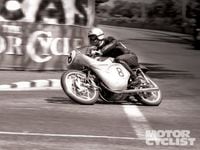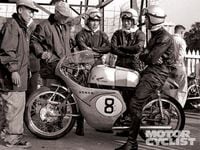Now it's an anachronism; a leftover from the days when roadrace circuits came with crosswalks and curbs. But in the mid-'50s the Isle of Man Tourist Trophy was the world's most important motorcycle race. A relative unknown, Soichiro Honda first visited the island in 1954, wandering the paddock in complete anonymity. Honda was making preparations to challenge the world's biggest motorcycle manufacturers on the international racing stage. He thought a TT win would elevate his eponymous motorcycles above other Japanese machines, and make the Honda name known far beyond Japanese borders-the first step in his ambitious global expansion plans.
That first visit to the TT was a reality check for Mr. Honda. The European racebikes were far more advanced than his best machines. The German-made NSU that won that year's 125cc race produced 18.5 horsepower, while the NSU 250 made 39 bhp. Honda's 220cc Dream 4E barely managed 8.5 horsepower. Honda would have his work cut out for him.
Armed with two suitcases full of racing parts he gathered in Europe (he abandoned his clothing in Rome, to comply with the airline's two-suitcase rule), Honda returned to his newly built R&D; center in Hamamatsu and commenced developing a dedicated racing motorcycle. That first works racer, code-named RC141, was a 125cc machine that borrowed heavily from the NSU Rennmax. Powered by a twin-cylinder engine with dual overhead cams driven by a vertical shaft, it pumped out a respectable 18 bhp.
In the summer of '59-five years after his first visit-Honda returned to the Isle of Man with a full racing team and a brace of RC142 (second-generation) racebikes. Gridded beside sophisticated MV Agustas, Ducatis and MuZs, the clunky Hondas (which still used low-tech, leading-link forks) looked outclassed. In fact, Honda's performance on the Isle's Clypse course ('59 was the last year 125s raced this shorter course, instead of the more-demanding Snaefell Mountain circuit) was less than impressive. Naomi Taniguchi, the highest-placed Honda rider (and the first Japanese racer to compete at the TT), finished sixth, more than 7 minutes behind MV-mounted race winner Tarquino Provini. But the Hondas were consistent: Finishing in sixth, seventh, eighth and 11th places earned the company that year's 125cc Manufacturer's Cup-the first of many international racing awards.
Honda vowed to return to the Isle and win-a promise he made good on in '61, when Mike Hailwood dominated the Ultra Lightweight TT on a 125cc Honda. That same day Hailwood earned Honda's second TT victory in the 250cc Lightweight event. Hailwood was crowned 250cc World Champion that same year-the first of five world titles that he would win riding Hondas. Honda motorcycles eventually scored seven individual TT victories and more than a dozen world championships, in every displacement category from 50 to 500cc, before withdrawing from international motorcycle competition in '67 to focus on Formula 1 car racing. It's a fairy-tale journey, an eight-year transformation from unknown obscurity to the most dominant name in racing. And it all began 50 years ago at the Isle of Man.












/cloudfront-us-east-1.images.arcpublishing.com/octane/3TIWWRV4JBBOLDVGRYECVVTA7Y.jpg)
/cloudfront-us-east-1.images.arcpublishing.com/octane/KIX5O23D5NAIBGFXBN3327DKZU.jpg)
/cloudfront-us-east-1.images.arcpublishing.com/octane/7GJYDUIPXRGMTMQKN6ONYOLBOU.jpg)
/cloudfront-us-east-1.images.arcpublishing.com/octane/MUQLOVLL2ZDGFH25ILABNBXKTI.jpg)
/cloudfront-us-east-1.images.arcpublishing.com/octane/TNOU5DNE2BC57MFPMGN2EIDXAM.jpg)
/cloudfront-us-east-1.images.arcpublishing.com/octane/GTCXACQGJ5HAPDTGWUQKDEH44E.jpg)
/cloudfront-us-east-1.images.arcpublishing.com/octane/S35YGSEMEZB4BLTDJTSZPF4GLA.jpg)
/cloudfront-us-east-1.images.arcpublishing.com/octane/5UOT6HPX2JFMRJAX6EH45AR4MQ.jpg)
/cloudfront-us-east-1.images.arcpublishing.com/octane/OKWOJWAKP5EP3OACCRRWPCIX2Q.jpg)
/cloudfront-us-east-1.images.arcpublishing.com/octane/2WF3SCE3NFBQXLDNJM7KMXA45E.jpg)
/cloudfront-us-east-1.images.arcpublishing.com/octane/G4MG6OUCJNBSHIS2MVVOTPX65E.jpg)
/cloudfront-us-east-1.images.arcpublishing.com/octane/IIGGWFOTOJGB7DB6DGBXCCMTDY.jpg)
/cloudfront-us-east-1.images.arcpublishing.com/octane/QSTCM6AVEZA5JJBUXNIQ3DSOF4.jpg)
/cloudfront-us-east-1.images.arcpublishing.com/octane/U4I7G625B5DMLF2DVIJDFZVV6M.jpg)
/cloudfront-us-east-1.images.arcpublishing.com/octane/B6XD6LS6IVCQPIU6HXDJSM3FHY.jpg)
/cloudfront-us-east-1.images.arcpublishing.com/octane/ICL63FEDDRDTTMINYICCEYGMDA.jpg)
/cloudfront-us-east-1.images.arcpublishing.com/octane/FCGZHQXRBZFLBAPC5SDIQLVF4I.jpg)
/cloudfront-us-east-1.images.arcpublishing.com/octane/WNOB6LDOIFFHJKPSVIWDYUGOPM.jpg)

/cloudfront-us-east-1.images.arcpublishing.com/octane/X33NU3E525ECRHXLNUJN2FTRKI.jpg)
/cloudfront-us-east-1.images.arcpublishing.com/octane/6KKT5NNL2JAVBOXMZYS5ZO76YA.jpg)
/cloudfront-us-east-1.images.arcpublishing.com/octane/J5RKG5O455GMPGQRF2OG6LRT7A.jpg)
/cloudfront-us-east-1.images.arcpublishing.com/octane/GX2CIZKQVRH2TATDM26KFG2DAE.jpg)
/cloudfront-us-east-1.images.arcpublishing.com/octane/ZWIDYSAKQZHD5BHREMQILXJCGM.jpg)